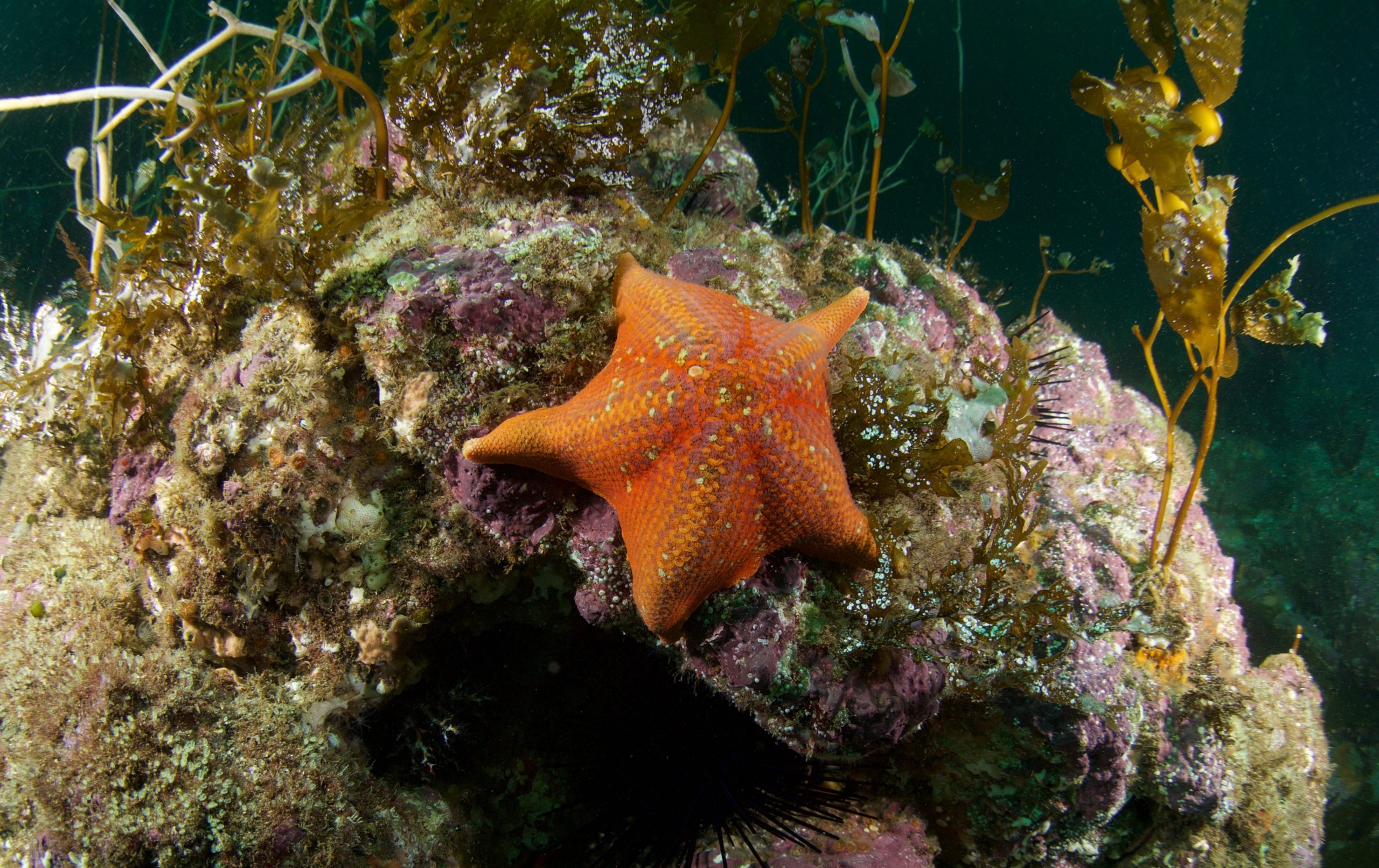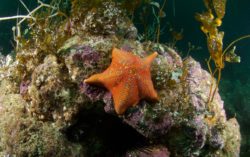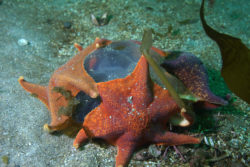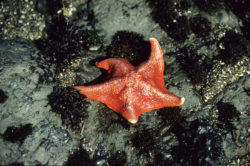
Sea Wonder: Bat Star

Bat star spotted in Channel Islands National Marine Sanctuary. Photo: Dr. Tony Knight
Bat stars (Patiria miniate) go by a few names, including the sea bat, webbed star, and broad-disk star — and what stars they are! These scavengers play vital roles in their ecosystems by cleaning algae and decaying animal tissue from the ocean floor, recycling nutrients into their food webs.
Description
A species of sea star, bat stars have five to nine arms that extend from their central body. Their arms are short and triangular and have a webbing between them that gives the animals a bat-like look. At the end of each arm is an eyespot that can detect light, and on the underside of each arm are tube feet that they can use to move and sense prey. Their average radius is four inches but can reach maximums of eight inches. They express a wide variety of colors, including red, orange, yellow, brown, green, and purple. Their skin is covered in gill-like structures, which gives them the appearance of a fuzzy texture. On the underside of their bodies, towards the center of their body, is a mouth opening where it extends its stomach out of and digests its food externally.
Diet & Habitat

Several bat stars eat a moon jelly at Monterey Bay National Marine Sanctuary. Photo: Chad King/NOAA
Bat stars are omnivores that scavenge for food on the seafloor. They are opportunistic, meaning they eat whatever is easiest to find and catch. Their diets are mostly comprised of tunicate worms, other sea stars, and algae, but decaying animal tissue and other invertebrates aren’t uncommon to find in their stomach contents. To feed, bat stars expel one of their two stomachs through their oral cavity and cover their victims in digestive enzymes before trapping the prey and pulling their stomach back into their bodies. When they can’t scavenge, they will expel their stomachs into the water column like a net to catch microorganisms. Polychaete worms are often seen living on the bat stars’ arm grooves or mouth cavities, which gives them a front-row seat for any leftover food scraps missed by the stars. The worms do not cause the stars any harm, nor do they provide the stars with any obvious benefits.
Natural predators of bat stars include other species of sea star, mollusks, and crustaceans. To avoid being eaten, bat stars cover their bodies in a bad-tasting mucus that deters their enemies.
Bat star populations are commonly found from the coastal waters of Alaska down America’s west coast and all the way down to Baja California Sur, Mexico including the west coast national marine sanctuaries. They tend to live near thriving ecosystems where food would be abundant, whether that is near reefs, kelp forests, or rocky intertidal areas. They can thrive in a range of environmental conditions including depth, salinity, and water temperatures.
Life History
Sea stars can reproduce through both asexual and sexual reproductive cycles. Asexual reproduction often involves the creation of genetic clones through a budding process where part of the parent star breaks off and grows into a new individual. Sexual reproduction generally occurs in the late summer by way of external spawning in which groups of bat stars release eggs and sperm from the gonads in their arms into the water column, where they merge to create embryos. These animals seem to have an unusually long reproductive season and may be able to produce fertilized eggs throughout the year.
Bat stars seem to guard their eggs by holding onto them under their bodies or between their arms until they hatch. Starfish larvae are microscopic and fairly helpless at birth, floating wherever the water column takes them and feeding on whatever passes them by. Over the course of about a month, the larvae go through several metamorphoses before reaching their adult life stage. Bat stars can live a maximum of 35 years.
Bat stars tend to be solitary animals, though individuals may live near each other. Bat stars seem quite gentle and docile due to their lethargic lifestyles, but they are territorial and will arm-wrestle other sea stars to protect a meal or their space.
Threats & Conservation
Bat star populations are generally stable, though they are vulnerable to threats like habitat loss, ocean acidification, coastal development and pollution, and climate change effects. An issue especially for these animals is sea star wasting disease, also known as sea star wasting syndrome. This disease spreads quickly and causes mass mortality in echinoderms like bat stars. Warming ocean temperatures due to climate change may be linked to this disease.

Bat star found in Greater Farallones National Marine Sanctuary. Photo: Dwayne Meadows/NOAA
